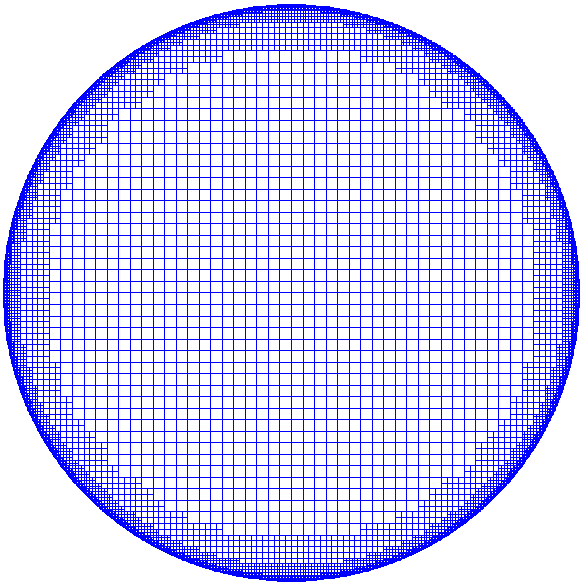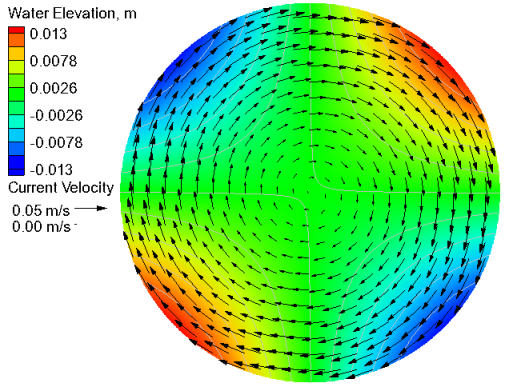Circular Basin: Difference between revisions
| Line 6: | Line 6: | ||
{{Equation| <math> f_c U + g \frac{\partial \eta}{\partial y} = \kappa V </math>|2=2}} | {{Equation| <math> f_c U + g \frac{\partial \eta}{\partial y} = \kappa V </math>|2=2}} | ||
where <math>U</math> and <math>V</math> are the depth-averaged current velocities in the <math>x</math> and <math>y</math> directions respectively, <math>g<math> is the gravitational constant, <math>\eta</math> is the water surface elevation with respect to mean sea level, <math>\kappa</math> is a linear bottom friction coefficient, <math>R</math> is the radius of the domain, <math>h</math> is the total water depth, and <math>W</math> is a constant equal to the gradient of the wind forcing. | where <math>U</math> and <math>V</math> are the depth-averaged current velocities in the <math>x</math> and <math>y</math> directions respectively, <math>g</math> is the gravitational constant, <math>\eta</math> is the water surface elevation with respect to mean sea level, <math>\kappa</math> is a linear bottom friction coefficient, <math>R</math> is the radius of the domain, <math>h</math> is the total water depth, and <math>W</math> is a constant equal to the gradient of the wind forcing. | ||
=Solution= | =Solution= | ||
Revision as of 22:24, 19 May 2011
UNDER CONSTRUCTION
Problem
Dupont (2001) presented an analytical solution for a closed circular domain on an f-plane with a linear bottom friction. The governing equations are
| (1) |
| (2) |
where and are the depth-averaged current velocities in the and directions respectively, is the gravitational constant, is the water surface elevation with respect to mean sea level, is a linear bottom friction coefficient, is the radius of the domain, is the total water depth, and is a constant equal to the gradient of the wind forcing.
Solution
The analytical solution for water surface elevation solution is given by
| (1) |
The current velocities are independent of the Coriolis parameter and are given by
| (3) |
| (4) |
Setup
The model is run to steady state from zero current and water level initial conditions with , , and . Table 1 shows the general settings used for CMS-Flow. Figure 1 shows the computational grid with 5 levels of refinement from 2000 m to 125 m.
Table 1. General Settings for Wind-driven flow in a circular basin
| Parameter | Value |
| Time step | 3600 s |
| Simulation Duration | 72 hrs |
| Ramp Period | 24 hrs |
| Initial Water Depth | 10 m |
| Mixing Terms | Off |
| Wall Friction | Off |
| Linear Bottom Friction Coefficient | 0.001 |
Results
Table 2. Goodness of fit statistics for the current velocity and water level
| Variable | RRMSE, % | RMAE, % | R^2 | Bias |
| U-Velocity | 3.88 | 0.64 | 0.997 | -4.06e-5 |
| V-Velocity | 3.87 | 0.64 | 0.997 | 4.06e-5 |
| Water Level | 0.16 | 0.13 | 1.000 | -3.56e-6 |
References
- Dupont, F., 2001. Comparison of numerical methods for modelling ocean circulation in basins with irregular coasts. Ph.D. thesis, McGill University, Montreal.












![{\displaystyle \eta ={\begin{cases}{\frac {W{{r}^{2}}\sin 2\theta }{4gHR}},&{\mbox{if }}f_{c}=0\\{\frac {W{{f}_{c}}}{RgH\kappa }}\left[{\frac {{R}^{2}}{8}}+{\frac {{r}^{2}}{4}}\left({\frac {\kappa }{{f}_{c}}}\sin 2\theta -1\right)\right],&{\mbox{if }}f_{c}\neq 0\\\end{cases}}}](https://en.wikipedia.org/api/rest_v1/media/math/render/svg/a6a520fbc80a3c73e500f657408d7e887d2718f5)







